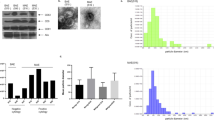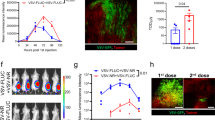Abstract
Malignant ascites is common in various types of cancers and is difficult to manage. Vascular endothelial growth factor (VEGF) has a pivotal role in malignant ascites. The matrix protein of vesicular stomatitis virus (VSVMP) has been shown to inhibit host gene expression and induce the apoptosis of cancer cells. The present study was designed to determine whether VSVMP suppresses the formation of ascites in ascites-producing peritoneal carcinomatosis. BALB/c female mice, 6–8 weeks old, bearing peritoneal tumors of H22 or MethA cells received an intraperitoneal administration of 50 μg VSVMP/250 μg liposome complexes, 50 μg empty plasmid/250 μg liposome complexes or 0.9% NaCl solution, respectively, every 2 days for 3 weeks. Administration of VSVMP resulted in a significant inhibition in ascites formation, improvement in health condition and prolonged survival of the treated mice. Decreased peritoneum osmolarity and reduced tumor vascularity coincided with dramatic reductions in the VEGF level in ascites fluid and plasma. Examination of floating tumor cells collected from the peritoneal wash revealed an apparently increased number of apoptotic cells and profound downregulation of VEGF mRNA in the VSVMP-treated mice. Our data indicate for the first time that in BALB/c mice bearing H22 or MethA cell peritoneal tumors, VSVMP may inhibit VEGF production and suppress angiogenesis, consequently abolishing ascites formation.
This is a preview of subscription content, access via your institution
Access options
Subscribe to this journal
Receive 12 print issues and online access
$259.00 per year
only $21.58 per issue
Buy this article
- Purchase on Springer Link
- Instant access to full article PDF
Prices may be subject to local taxes which are calculated during checkout









Similar content being viewed by others
Abbreviations
- e–p:
-
50 μg empty plasmid pcDNA3.1/250 μg liposome complexes
- i.p.:
-
intraperitoneally
- NS:
-
0.9% NaCl solution
- VSV:
-
vesicular stomatitis virus
- VSVMP:
-
VSV matrix protein-cDNA/250 μg liposome complexes
References
Taber CW . Taber’s Cyclopedic Medical Dictionary. FA Davies Co: Philadelphia (PA), USA, 1965: A–92.
Spratt JS, Edwards M, Kubota T, Lindberg R, Tseng MT . Peritoneal carcinomatosis: anatomy, physiology, diagnosis, management. Curr Probl Cancer 1996; 10: 558–584.
Chung M, Kozuch P . Treatment of malignant ascites. Curr Treat Options Oncol 2008; 9: 215–233.
Diaz RM, Galivo F, Kottke T, Wongthida P, Qiao J, Thompson J et al. Oncolytic immunovirotherapy for melanoma using vesicular stomatitis virus. Cancer Res 2007; 67: 2840–2848.
Fernandez M, Porosnicu M, Markovic D, Barber GN . Genetically engineered vesicular stomatitis virus in gene therapy: application for treatment of malignant disease. J Virol 2000; 76: 895–904.
Balachandran S, Porosnicu M, Barber GN . Oncolytic activity of vesicular stomatitis virus is effective against tumors exhibiting aberrant p53, Ras, or myc function and involves the induction of apoptosis. J Virol 2001; 75: 3474–3479.
Stojdl DF, Lichty B, Knowles S, Marius R, Atkins H, Sonenberg N et al. Exploiting tumor-specific defects in the interferon pathway with a previously unknown oncolytic virus. Nat Med 2000; 6: 821–825.
Letchworth GJ, Rodriguez LL, Del cbarrera J . Vesicular stomatitis. Vet J 1999; 157: 239–260.
Forger JM, Bronson RT, Huang AS, Reiss CS . Murine infection by vesicular stomatitis virus: initial characterization of the H-2d system. J Virol 1991; 65: 4950–4958.
Huneycutt BS, Bi Z, Aoki CJ, Reiss CS . Central neuropathogenesis of vesicular stomatitis virus infection of immunodeficient mice. J Virol 1993; 67: 6698–6706.
Sur JH, Allende R, Doster AR . Vesicular stomatitis virus infection and neuropathogenesis in the murine model are associated with apoptosis. Vet Pathol 2003; 40: 512–520.
Koyama AH . Induction of apoptotic DNA fragmentation by the infection of vesicular stomatitis virus. Virus Res 1995; 37: 285–290.
Ahmed M, Lyles DS . Effect of vesicular stomatitis virus matrix protein on transcription directed by host RNA polymerases I, II, and III. J Virol 1998; 72: 8413–8419.
Kopecky SA, Lyles DS . The cell-rounding activity of the vesicular stomatitis virus matrix protein is due to the induction of cell death. J Virol 2003; 77: 5524–5528.
Lyles DS, McKenzie MO . Activity of vesicular stomatitis virus M protein mutants in cell rounding is correlated with the ability to inhibit host gene expression and is not correlated with virus assembly function. Virology 1997; 229: 77–89.
Blondel D, Harmison GG, Schubert M . Role of matrix protein in cytopathogenesis of vesicular stomatitis virus. J Virol 1990; 64: 1716–1725.
Gromeier M, Wimmer E . Viruses for the treatment of malignant glioma. Curr Opin Mol Ther 2001; 3: 503–508.
Lin X, Chen X, Wei Y, Zhao J, Fan L, Wen Y et al. Efficient inhibition of intraperitoneal human ovarian cancer growth and prolonged survival by gene transfer of vesicular stomatitis virus matrix protein in nude mice. Gynecol Oncol 2007; 104: 540–546.
Luo S et al. Combination of vesicular stomatitis virus matrix protein gene therapy with low-dose cisplatin improves therapeutic efficacy against murine melonoma. Cancer Sci 2010; 101: 1219–1225.
Stoeltzing O, Ahmad SA, Liu W, McCarty MF, Parikh AA, Fan F et al. Angiopoietin-1 inhibits tumour growth and ascites formation in a murine model of peritoneal carcinomatosis. Br J Cancer 2002; 87: 1182–1187.
Kobayashi H, Yagyu T, Inagaki K, Kondo T, Suzuki M, Kanayama N et al. Bikunin plus paclitaxel markedly reduces tumor burden and ascites in mouse model of ovarian cancer. Int J Cancer 2004; 110: 4–139.
Gorczyca W, Gong J, Ardelt B, Traganos F, Darzynkiewicz Z . The cell cycle related differences in susceptibility of HL-60 cells to apoptosis induced by various antitumor agents. Cancer Res 1993; 53: 3186–3192.
Barry MA, Reynolds JE, Eastman A . Etoposide-induced apoptosis in human HL-60 cells is associated with intracellular acidification. Cancer Res 1993; 53: 2349–2357.
Belotti D, Paganoni P, Manenti L, Garofalo A, Marchini S, Taraboletti G et al. Matrixmetalloproteinases (MMP9 and MMP2) induce the release of vascular endothelial growth factor (VEGF) by ovarian carcinoma cells: implications for ascites formation. Cancer Res 2003; 63: 5224–5229.
Bergers G, Brekken R, McMahon G, Vu TH, Itoh T, Tamaki K et al. Matrix metalloproteinase-9 triggers the angiogenic switch during carcinogenesis. Nat Cell Biol 2000; 2: 737–744.
Hirabayashi K, Graham J . Genesis of ascites in ovarian cancer. Am J Obstet Gynecol 1970; 106: 492–497.
Senger DR, Galli SJ, Dvorak AM, Perruzzi CA, Harvey VS, Dvorak HF . Tumor cells secrete a vascular permeability factor that promotes accumulation of ascites fluid. Science 1983; 219: 983–985.
Garrison RN, Kaelin LD, Heuser LS, Galloway RH . Malignant ascites clinical and experimental observations. Ann Surg 1986; 203: 644–649.
Garrison RN, Galloway RH, Heuser LS . Mechanisms of malignant ascites production. J Surg Res 1987; 42: 126–132.
Luo JC, Yamaguchi S, Shinkai A, Shitara K, Shibuya M . Significant expression of vascular endothelial growth factor/vascular permeability factor inmouse ascites tumors. Cancer Res 1998; 58: 2652–2660.
Luo JC, Toyoda M, Shibuya M . Differential inhibition of fluid accumulation and tumor growth in two mouse ascites tumors by an antivascular endothelial growth factor/permeability factor neutralizing antibody. Cancer Res 1998; 58: 2594–2600.
Shibuya M, Luo JC, Toyoda M, Yamaguchi S . Involvement of VEGF and its receptors in ascites tumor formation. Cancer Chemother Pharmacol 1999; 43: S72–S77.
Liu CD, Tilch L, Kwan D, McFadden DW . Vascular endothelial growth factor is increased in ascites frommetastatic pancreatic cancer. J Surg Res 2002; 102: 31–34.
Yoneda J, Kuniyasu H, Crispens MA, Price JE, Bucana CD, Fidler IJ . Expression of angiogenesis related genes and progression of human ovarian carcinomas in nude mice. J Natl Cancer Inst 1998; 90: 447–454.
Akutagawa N, Nishikawa A, Iwasaki M, Fujimoto T, Teramoto M, Kitajima Y et al. Expression of vascular endothelial growth factor and E-cadherin in human ovarian cancer: Association with ascites fluid accumulation and peritoneal dissemination in mouse ascites model. Jpn J Cancer Res 2002; 93: 644–651.
Hu L, Hofmann J, Zaloudek C, Ferrara N, Hamilton T, Jaffe RB et al. Vascular endothelial growth factor immunoneutralization plus paclitaxelmarkedly reduces tumor burden and ascites in athymic mouse model of ovarian cancer. Am J Pathol 2002; 161: 1917–1924.
Yeo KT, Wang HH, Nagy JA, Sioussat SR, Ledbetter SR, Hoogewerf AJ et al. Vascular permeability factor (vascular endothelial growth factor) in guinea pig and human tumor and inflammatory effusions. Cancer Res 1993; 53: 2912–2916.
Zebrowski BK, Yano S, Liu W, Shaheen RM, Hicklin DJ, Putnam JB et al. Vascular endothelial growth factor levels and induction of permeability in malignant pleural effusions. Clin Cancer Res 1999; 5: 3364–3368.
Kraft A, Weindel K, Ochs A, Marth C, Zmija J, Schumacher P et al. Vascular endothelial growth factor in the sera and effusions of patients with malignant and nonmalignant disease. Cancer 1999; 85: 178–187.
Grunstein J, Roberts WG, Mathieu-Costello O, Hanahan D, Johnson RS . Tumor-derived expression of vascular endothelial growth factor is a critical factor in tumor expansion and vascular function. Cancer Res 1999; 59: 1592–1598.
Nagy JA, Masse EM, Herzberg KT, Meyers MS, Yeo KT, Yeo TK et al. Pathogenesis of ascites tumor growth: vascular permeability factor, vascular hyperpermeability, and ascites fluid accumulation. Cancer Res 1995; 55: 360–368.
Hasumi Y, Mizukami H, Urabe M, Kohno T, Takeuchi K, Kume A et al. Soluble FLT-1 expression suppresses carcinomatous ascites in nude mice bearing ovarian cancer. Cancer Res 2002; 62: 2019–2023.
Senger DR, Galli SJ, Dvorak AM, Perruzzi CA, Harvey VS, Dvorak HF . Tumor cells secrete a vascular permeability factor that promotes accumulation of ascites fluid. Science 1983; 219: 983–985.
Senger DR, Perruzzi CA, Feder J, Dvorak HF . A highly conserved vascular permeability factor secreted by a variety of human and rodent tumor cell lines. Cancer Res 1986; 46: 5629–5632.
Kobold S, Hegewisch-Becker S, Oechsle K, Jordan K, Bokemeyer C, Atanackovic D . Intraperitoneal VEGF inhibition using bevacizumab: a potential approach for the symptomatic treatment of malignant ascites? Oncologist 2009; 14: 1242–1251.
Zhong Q, Wen YJ, Yang HS, Luo H, Fu AF, Yang F et al. Efficient inhibition of cisplatin-resistant human ovarian cancer growth and prolonged survival by gene transferred vesicular stomatitis virus matrix protein in nude mice. Ann Oncol 2008; 19: 1584–1591.
Leung DW, Cachianes G, Kuang WJ, Goeddel DV, Ferrara N . Vascular endothelial growth factor is a secreted angiogenic mitogen. Science 1989; 246: 1306–1309.
Conn G, Bayne ML, Soderman DD, Kwok PW, Sullivan KA, Palisi TM et al. Amino acid and cDNA sequences of a vascular endothelial cell mitogen that is homologous to platelet-derived growth factor. Proc Natl Acad Sci USA 1990; 87: 2628–2632.
Acknowledgements
This study was supported, in part, by the Project of the National Natural Science Foundation of China (no. 81071862).
Author information
Authors and Affiliations
Corresponding author
Ethics declarations
Competing interests
The authors declare no conflict of interest.
Rights and permissions
About this article
Cite this article
Zhou, Y., Wen, F., Zhang, P. et al. Matrix protein of vesicular stomatitis virus: a potent inhibitor of vascular endothelial growth factor and malignant ascites formation. Cancer Gene Ther 20, 178–185 (2013). https://doi.org/10.1038/cgt.2013.7
Received:
Revised:
Accepted:
Published:
Issue Date:
DOI: https://doi.org/10.1038/cgt.2013.7



